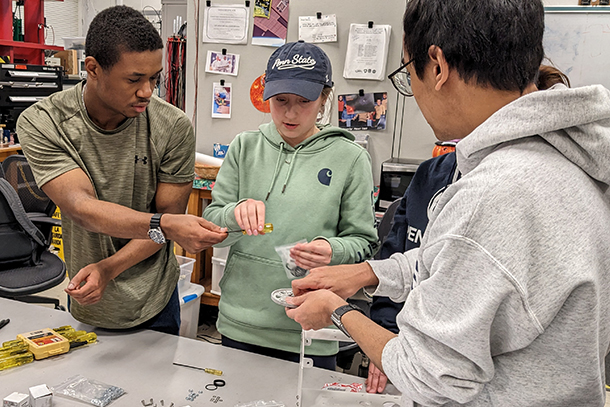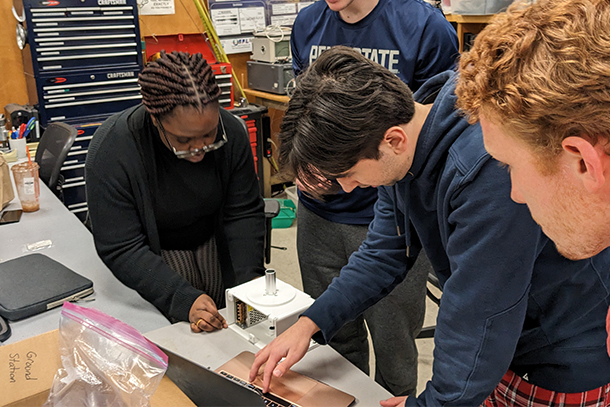
Students from the Penn State Student Space Programs Lab work to assemble scientific ballooning equipment that will be used in the 2023-24 Nationwide Eclipse Ballooning Project. Credit: Provided by Jesse McTernan. All Rights Reserved.
Penn State team to participate in NASA's Nationwide Eclipse Ballooning Project
April 6, 2023
By Sarah Small
UNIVERSITY PARK, Pa. — A team co-led by the Penn State Student Space Programs Lab (SSPL) has been selected as one of 70 teams to participate in the 2023-24 Nationwide Eclipse Ballooning Project (NEBP), co-sponsored by NASA and the National Science Foundation.
According to its website, the goal of NEBP is to launch scientific balloons nationwide during the October 2023 and April 2024 solar eclipses to collect and analyze data, while also providing learning opportunities and experiences for STEM college students from several higher education institutions. NEBP, which also operated during the 2017, 2019 and 2020 total solar eclipses, has an engineering track and an atmospheric sciences track. As participants on the engineering track, the SSPL-led team will integrate three payloads, which will operate before, during and after the eclipses: a NASA payload that will live-stream video to the NASA eclipse website, a payload designed by SSPL to measure atmospheric conductivity in situ and a payload designed by Lincoln University that will detect solar wind.
“This project, like many projects SSPL does, gives a purpose for learning and does so in a hands-on environment,” said Patrick Donato, a junior majoring in aerospace engineering who is one of the co-leads for the Penn State NEBP team. “Doing a project on such a large scale as this has given me a sense of responsibility to SSPL and to project sponsors. There are people counting on me. We have a very bright team of students, and I am excited to work with them as we enter the build phase later this semester and into the summer.”
Mechanical engineering sophomore Leigha Schrader, who leads a subsystem project for the atmospheric sensing payload, echoed Donato’s enthusiasm.
“Being new to scientific ballooning, I have learned a lot,” she said. “I hope to get new experience working in a team and using the engineering processes we learned in class, from mentors and from the NEBP sponsors. Of course, I hope that we are successful, and we are able to collect usable data.”

Students from the Penn State Student Space Programs Lab assemble a ground station that will direct a high-gain antenna toward the high-altitude balloon to download real-time video during the eclipse. Credit: Provided by Jesse McTernan. All Rights Reserved.
The Penn State faculty leads for the project are principal investigator (PI) Jesse McTernan, associate director of SSPL and assistant teaching professor in the School of Engineering Design and Innovation, and co-PI Sven Bilén, director of SSPL and professor of engineering design, of electrical engineering and of aerospace engineering. The Penn State group is partnering with a faculty co-PI and students from Lincoln University, the nation’s first degree-granting historically Black college and university.
“The eclipse ballooning project is expected to help our students with their capstone work and with networking,” said Andrey Semichaevsky, associate professor and coordinator for engineering and physics at Lincoln University. “Our team will be launching a payload that includes a solar wind particle detector and an instrument to study solar cell efficiency.”
According to the project proposal, the goals of the team are training, collaboration and experience, which are in line with all the projects that emerge from SSPL.
“SSPL’s projects have to have a scientific goal or have some possibility to advance the state of the art and our scientific understanding,” Bilén said. “We want to accomplish real things related to space research. And that’s what the NEBP program is all about.”
Throughout the spring semester, the Penn State team plans to continue building their student membership. The team will also attend NASA-sponsored workshops in May. Some students will have the opportunity for internships over the summer to stay and continue their work on the project. The work will culminate with a full-scale campaign during the total eclipse in April 2024. A test run will occur during the annular solar eclipse on Oct. 14.
“This is unique opportunity for students to design, fabricate, test and fly a real-world system that will advance scientific understanding,” McTernan said. “It should be noted that these are undergraduate students engaging with scientists and engineers to collectively advance our understanding of space science. This project will stretch them in a good way. It will build their leadership skills and put engineering principles taught in the classroom into practice.”
The Pennsylvania Space Grant Consortium provides monetary support to SSPL and for SSPL’s participation in NEBP.



